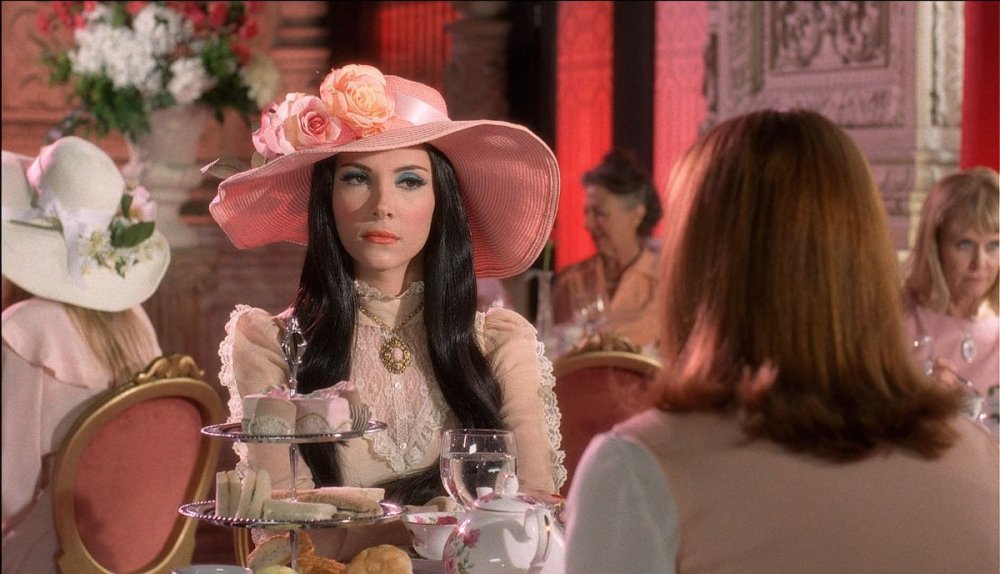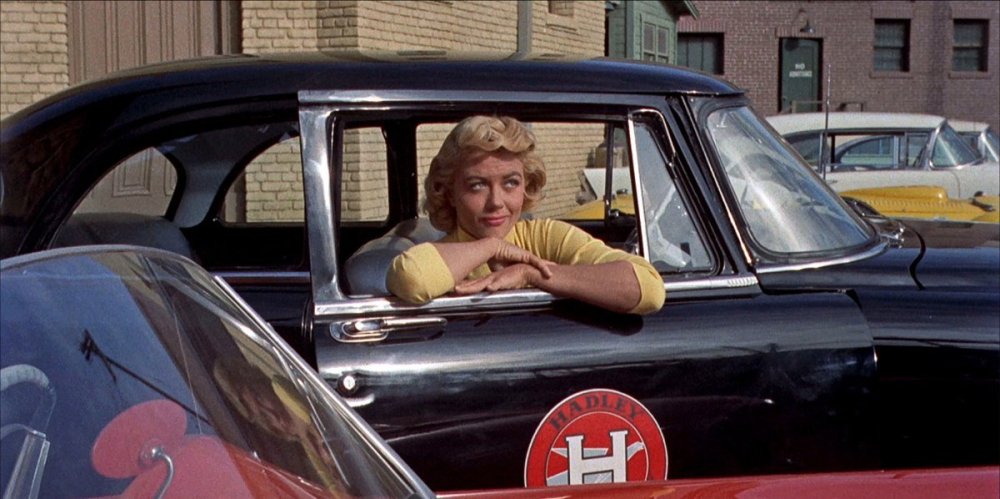-
Posts
22,410 -
Joined
-
Last visited
Everything posted by David Mullen ASC
-

Pre-lighting - Any suggestions?
David Mullen ASC replied to Nicolas U Hepburn's topic in Lighting for Film & Video
Seems fine for a wide master if you don't want just flat softlight overhead. In the singles I would have lowered and softened the light to feel more like they were coming from table lamps. Also a face doesn't always have to be at full exposure if the source isn't that close to them. -
FCP color processing of motion picture print stock is very automated / standardized, it's not really designed to be manipulated but maybe a small lab would be willing to try. I'm not sure why you are so against pushing the negative but want to push around the print stock... Anyway, Fotokem once had a demo of a high-contrast print image created I think by using a color print as an interpositive (still requiring a dupe negative be made for printing.) I could be mistaken. I still think all of these ideas are going far beyond recreating the look of 1950s/1960s color negative stocks -- they weren't THAT weird in color and contrast... Plus all of this is just to get a 16mm contact print that you can project? There's no need for a digital master, no D.I., you're going to A-B roll cut the negative, etc.? Because as soon as you have the option of digitally color-correcting the image, then changing saturation and contrast is relatively simple.
-

Recommended Filters to saturate image
David Mullen ASC replied to Ben Kahn's topic in Cinematographers
Polarizers help reduce glare off of reflective surfaces which can improve saturation so sure, try that. The only other filter that increases saturation are color enhancers but those mainly work on warm tones; they make fall leaves look more intense but they can also make faces look a bit plum-colored now and then so be careful. The truth is that increasing color saturation is fairly easy with digital. -
You can expose whatever you want to 3383 (16mm) but it was designed to create a projection contrast positive from a negative or dupe negative that has an orange color mask. So if you exposed a positive 3383 print image onto it, you'd get a high-contrast negative image with no orange color mask. You could print that again to 3383 to reverse it back to a positive image but then it would be very high in contrast, probably with some off colors. Film copying is always a negative to positive to negative, etc. process unless there is reversal film & processing involved. You also have to factor in that contact printing is usually emulsion-side to emulsion-side.
-
I think suggestions like using reversal or dupe stock or print stock as camera negative are too extreme to match color negative film of the 50's, unless you're trying to create some sort of degraded-over-time effect, like a transfer from an old print or something that got duped badly. It would be simpler to just push slower-speed camera negative stock a stop to reduce some dynamic range and add contrast, and then play with it in post. After that, it's really about lenses, filters, lighting, production design -- matching the general aesthetic values of people of the past in what they considered "proper" cinematography. That's the problem with creating the look of these old movies, it's all tied up in what we saw -- an old print (fading to magenta), a new print of an old negative (with yellow dye fade), a digital restoration from the negative, from YCMs, or a mix, from old IP, did we see it projected in 35mm, digitally (2K, 4K, laser, etc.), on blu-ray, etc. Too many variables.
-
Here is a shot from dailies for "The Love Witch" -- in this case 250D instead of 200T because I couldn't gel the daylight windows. Zeiss Super Speeds (so a bit sharper than the Cookes and Baltars of the 50's and 60's) but with some diffusion on the lens (a light net combined with a 1/8 Classic Soft filter.)
-
You could look at something like this blu-ray transfer of "Written on the Wind" (1956) for example. Probably not a scan of the original negative. Despite being shot on 25 ASA stock (5248), it's not super fine-grained for example, and not super sharp either -- despite being shot under full sunlight.
-
The older color negative stocks were softer and grainier for their speed than modern stocks, and had less dynamic range. And the print stocks of the day didn't help in that regard. To some degree, pushing something like 200T one-stop (maybe without underexposing it) would help get closer to the look if combined with softer lenses. But the problem with replicating 1950's film stocks is that you have no accurate references -- these negatives have either faded a lot, particularly the yellow dye layer (blues), or you're seeing something made from a YCM separation that preserved the color but often at the expense of more contrast and grain. Recent digital restorations have gotten closer, sometimes by combining the cyan and magenta layers from a scan of the original negative with the yellow layer (blue) coming from one of the YCMs. But many blu-rays are transfers using older interpositives, etc. At some point, it's more about creating the feeling of these old stocks rather than a technical recreation of them.
-

Recreating a partial window reflection effect
David Mullen ASC replied to silvan schnelli's topic in General Discussion
Seems like a natural reflection. Actually the darker background in the room makes it easier to get reflections on the foreground yard compared to having lighter toned curtains, so probably they covered part of the yard being reflected with some black flags to keep it off of the actor area in the room. Of course, one could add reflections in post instead. Yes, you need to bring up the interior quite a bit to balance with the reflections. -

Cinematography.com's David Mullen wins ASC award
David Mullen ASC replied to Jeff Bernstein's topic in General Discussion
You're welcome! -

Creating a big shaft of light
David Mullen ASC replied to Chris Saul's topic in Lighting for Film & Video
Depends on a lot of factors, like what is cutting the light into a shaft, is there a window frame? How large? Does the light have to fill it? Or is this is empty space where the light itself has to contain itself into a shaft? How much of a spread do you want? How much intensity? How far can you place the light? How even in exposure do you want the area where the light hits? -

Darkening the Sky (Double 85 Filtering)
David Mullen ASC replied to Evin Cameron's topic in Lenses & Lens Accessories
It would be easy to take stills to see the effect of using two 85 filters on a blue sky and correcting back to neutral versus normal filtering, but again, assuming digital color-correction, it's just as easy to darken the blue channel in post if that's what you want. -

Darkening the Sky (Double 85 Filtering)
David Mullen ASC replied to Evin Cameron's topic in Lenses & Lens Accessories
In that example, there was a lot of overall contrast added somewhere in the chain, probably in color-correction. And of course, in digital color-correction, you can isolate the blue channel and darken it. The first 85 filter on tungsten stock just gets you to neutral, as if you shot daylight stock. The second one warms up the image quite a bit; that will slightly darken a blue sky but it's more that by making the image more orange, the blue sky stands out a little more (of course, the orange filter also makes it less blue, it shifts a bit to the green.) If you have a really blue sky like that, a pola filter will do more to darken and saturate it, but if you like the orange highlights, then go ahead and use the extra 85 filter. Or do both, or use an 85/Pola combo so there is only one piece of glass. But keep in mind that your reference photo is higher in contrast than normal, and increasing the contrast tends to increase the saturation. -

More than 1 Eye Light Reflections?
David Mullen ASC replied to Wenqi Wei's topic in Lighting for Film & Video
There can be multiple reflections in the eye, just as in real life. If anything, the traditional center point eye light is what is unnatural. -
Yes that is anamorphic lens breathing which is a bit different-looking than spherical lens breathing due to the change in compression/squeezing to the background as it goes out of focus, but there’s also probably a bit of traditional breathing (focal length shift) mixed in with that. Anamorphic mumps as with CinemaScope is an entirely different issue, that’s when as you follow-focus to a face getting closer, the squeeze starts to become less than 2X, so during consistent 2X unsqueezing during projection, the face starts to look fatter.
-

Shooting Color Neg for B&W
David Mullen ASC replied to Frank Poole's topic in Film Stocks & Processing
A number of movies have done that -- "Good Night and Good Luck" as well I believe. Shooting color and turning it b&w, whether digital or film, has been more common over the years. Truth is, if you want really clean b&w, shoot digital like "Ida" for example. B&W reversal was mainly just a lot more high-contrast, sharper, and generally finer-grained (depending on the stock) than b&w negative, so you can increase contrast in post but contrasty lighting will also help.- 12 replies
-
- 16mm
- color negative
-
(and 3 more)
Tagged with:
-
Nothing wrong with warming up skin tones by lighting through unbleached muslin, but being a daylight source, if the camera was set to 3200K, then the light isn't warm, it's still cool. You can make that light look warm, cool, or neutral depending on your base color temperature setting. Your colorist should be more clear as to what the problem was with color-correcting the skin tones in the shot, too green, too magenta, too desaturared, too saturated? Was the camera set-up properly for the color rendition you intended?
-

μεταμορφώσεις
David Mullen ASC replied to Jeff Bernstein's topic in Students, New Filmmakers, Film Schools and Programs
I had the same experience with a screening of "2001", the audience found the deadpan dialogue very funny ("Without your space helmet, Dave... I think you'll find it... very difficult.") And I don't think they were wrong to laugh. -

HIGH KEY LIGHTING and LOW KEY LIGHTING
David Mullen ASC replied to B. Sakthidoss's topic in Lighting for Film & Video
"Key" exposure generally just means exposing the subject for what the meter says will render the subject with "normal" brightness. It could be f/16 or f/2.8! A low-key image has smaller areas of normal brightness, even a few tiny areas of overexposure, but a large amount of the frame is very underexposed or black. It's not a scientific term, it's describing a feeling. -
A diffusion filter is only necessary if you think it is necessary based on your visual goals and the image you are getting on the set. It certainly doesn't hurt to carry some filters even if you end up not using them, just in case the sharpness of the image is too unflattering or if you desire a certain effect like glowing highlights. However, keep in mind that if you don't really know whether you need the filters or not, you could always just shoot clean and do the filtering in post if it turned out to be necessary after-the-fact; you aren't stuck with a too-sharp image (but you can be stuck with a too-soft image). There are different types of diffusion filters, some are "mist" filters that cause bright areas to halate, often causing some loss of contrast while softening the image, others blur fine details but don't contribute much halation. Some combine a mist filter and a softening filter. You just have to decide what look you want and why you are using the filter.
-
You’d cross-dissolve two passes of the same shot on two IP copies onto a new negative, one IP with the blurred areas. Now how they blurred it, I don’t know — perhaps just on a clear piece of film in front of the IP in the projector gate of the optical printer, with some Vaseline applied with a paint brush.






